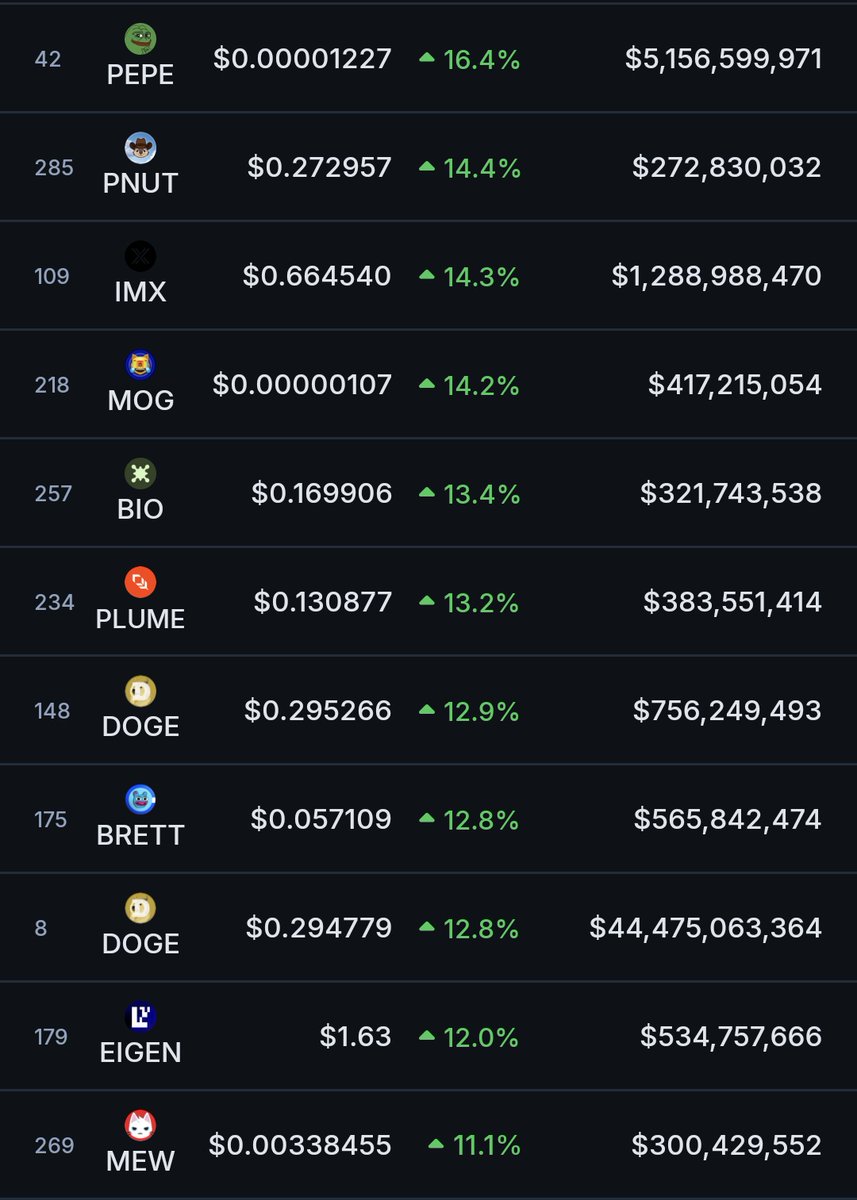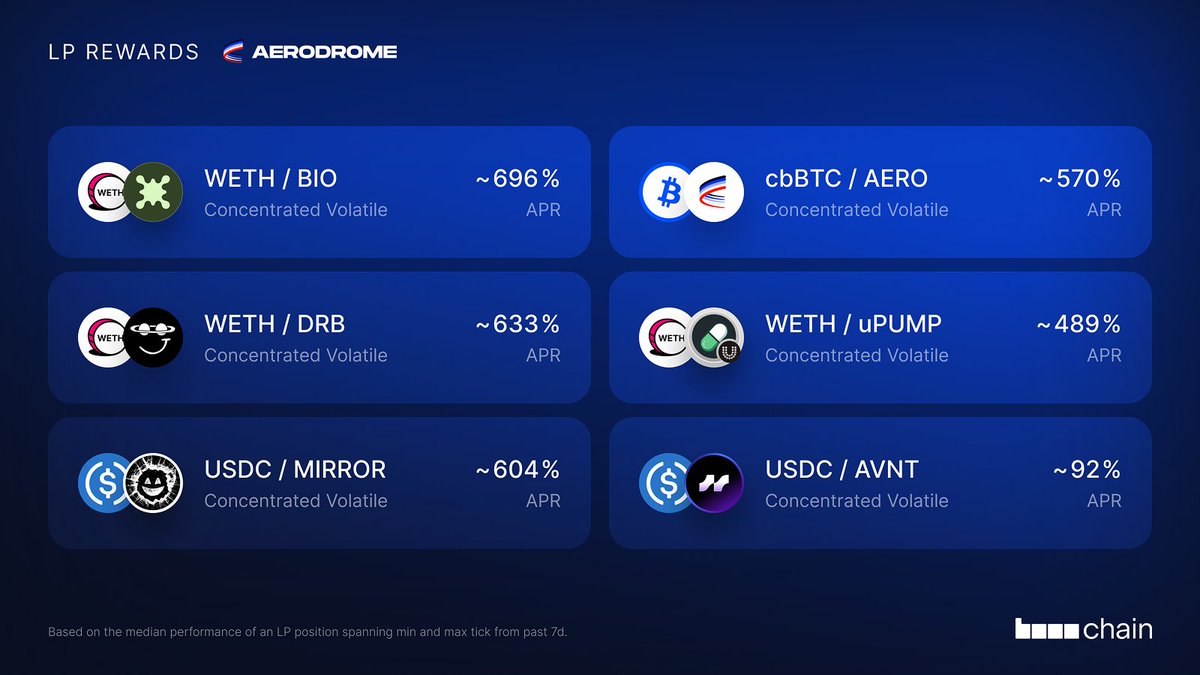BIO-Preis
in USD$0,17927
+$0,02683 (+17,60 %)
USD
Wir haben nichts gefunden. Überprüfe die Schreibweise oder suche nach etwas anderem.
Marktkapitalisierung
$343,91 Mio. #102
Umlaufmenge
1,91 Mrd. / 3,32 Mrd.
Allzeithoch
$0,9075
24-Std.-Volumen
$250,63 Mio.
3.9 / 5


Über BIO
Haftungsausschluss
Der soziale Inhalt auf dieser Seite („Inhalt”), einschließlich, aber nicht beschränkt auf Tweets und Statistiken, die von LunarCrush bereitgestellt werden, stammt von Dritten und wird „wie gesehen” ausschließlich zu Informationszwecken bereitgestellt. OKX übernimmt keine Garantie für die Qualität oder Richtigkeit des Inhalts, und der Inhalt spiegelt nicht die Ansichten von OKX wider. Die Inhalte dienen nicht dazu, (i) Investitionsberatung oder Investitionsempfehlungen zu geben, (ii) ein Angebot oder eine Aufforderung zum Kauf, Verkauf oder Halten digitaler Assets darzustellen oder (iii) finanzielle, buchhalterische, rechtliche oder steuerliche Beratung zu leisten. Digitale Assets, einschließlich Stablecoins und NFTs, sind mit einem hohen Risiko verbunden, ihr Wert kann stark schwanken. Preis und Wertentwicklung digitaler Assets sind nicht garantiert und können sich ohne Vorankündigung ändern.
OKX gibt keine Investitions- oder Vermögensempfehlungen. Du solltest sorgfältig prüfen, ob der Handel oder das Halten digitaler Assets angesichts deiner finanziellen Situation für dich geeignet ist. Bei Fragen zu deiner individuellen Situation wende dich bitte an deinen Rechts-/Steuer- oder Anlagenexperten. Weitere Einzelheiten findest du in unseren Nutzungsbedingungen und der Risikowarnung. Durch die Nutzung der Website eines Drittanbieters („TPW“) akzeptierst du, dass jegliche Nutzung der TPW den Bedingungen der TPW unterliegt. Sofern nicht ausdrücklich schriftlich angegeben, steht OKX einschließlich seiner verbundenen Unternehmen („OKX“) in keinerlei Verbindung zum Eigentümer oder Betreiber der TPW. Du stimmst zu, dass OKX nicht für Verluste, Schäden oder sonstige Folgen haftet, die sich aus deiner Nutzung der TPW ergeben. Bitte beachte, dass die Nutzung einer TPW zu einem Verlust oder einer Minderung deiner Assets führen kann. Das Produkt ist möglicherweise nicht in allen Ländern verfügbar.
OKX gibt keine Investitions- oder Vermögensempfehlungen. Du solltest sorgfältig prüfen, ob der Handel oder das Halten digitaler Assets angesichts deiner finanziellen Situation für dich geeignet ist. Bei Fragen zu deiner individuellen Situation wende dich bitte an deinen Rechts-/Steuer- oder Anlagenexperten. Weitere Einzelheiten findest du in unseren Nutzungsbedingungen und der Risikowarnung. Durch die Nutzung der Website eines Drittanbieters („TPW“) akzeptierst du, dass jegliche Nutzung der TPW den Bedingungen der TPW unterliegt. Sofern nicht ausdrücklich schriftlich angegeben, steht OKX einschließlich seiner verbundenen Unternehmen („OKX“) in keinerlei Verbindung zum Eigentümer oder Betreiber der TPW. Du stimmst zu, dass OKX nicht für Verluste, Schäden oder sonstige Folgen haftet, die sich aus deiner Nutzung der TPW ergeben. Bitte beachte, dass die Nutzung einer TPW zu einem Verlust oder einer Minderung deiner Assets führen kann. Das Produkt ist möglicherweise nicht in allen Ländern verfügbar.
Preisentwicklung von BIO
Vergangenes Jahr
--
--
3 Monate
+217,68 %
$0,06
30 Tage
+86,31 %
$0,10
7 Tage
+9,13 %
$0,16
BIO auf Social Media
Anleitungen
Finde heraus, wie du BIO kaufen kannst
Der Einstieg in Kryptowährungen kann sich überwältigend anfühlen, aber zu erfahren, wo und wie man Kryptowährungen kaufen kann, ist einfacher, als du vielleicht denkst.
Prognostiziere die Preise von BIO
Wie viel wird BIO in den nächsten Jahren wert sein? Sieh dir die Meinung der Community an und mache deine Prognosen.
Sieh dir die Preisentwicklung von BIO an
Verfolgen Sie den Preisverlauf Ihrer BIO, um die Entwicklung Ihrer Beteiligungen im Laufe der Zeit zu verfolgen. Sehen Sie die Eröffnungs-/Schlusswerte, Höchst- und Tiefststände sowie das Handelsvolumen ganz einfach in der unten stehenden Tabelle ein.

Erhalte BIO in 3 Schritten
Erstelle ein kostenloses OKX-Konto.
Zahle Gelder auf dein Konto ein.
Wähle deine Krypto aus.
Häufig gestellte Fragen zum BIO-Preis
Aktuell liegt der BIO-Kurs bei $0,17927. Was kostet ein BIO? – die Antwort auf diese Frage hängt stark von Angebot, Nachfrage und Marktstimmung ab. Wenn du aktuelle Kursdaten und Einblicke in die Preisentwicklung suchst, bist du hier genau richtig. Entdecke die neuesten BIO-Charts und handel verantwortungsbewusst mit OKX.
Kryptowährungen, wie etwa BIO, sind digitale Vermögenswerte, die auf einem öffentlichen Hauptbuch namens Blockchains betrieben werden. Erfahre mehr über die auf OKX angebotenen Coins und Tokens sowie deren unterschiedlichen Eigenschaften, einschließlich Live-Preisen und Charts in Echtzeit.
Dank der Finanzkrise von 2008 ist das Interesse an einem dezentralen Finanzwesen rasant gestiegen. Bitcoin bot als sicherer digitaler Vermögenswert auf einem dezentralen Netzwerk eine neuartige Lösung. Seitdem wurden auch viele andere Token, wie etwa BIO, erstellt.
Auf unserer BIO-Seite für Preisprognosen findest du Prognosen zukünftiger Preise und kannst deine Preisziele bestimmen.
Tauch tiefer ein in BIO
BIO Protocol ist ein DeSci-Finanzlayer, der Kapital und Talente in die On-Chain-Wissenschaften treibt.
ESG-Offenlegung
ESG-Regulierungen (Umwelt, Soziales und Governance) für Krypto-Vermögenswerte zielen darauf ab, ihre Umweltauswirkungen (z. B. energieintensives Mining) zu adressieren, Transparenz zu fördern und ethische Governance-Praktiken zu gewährleisten, um die Krypto-Industrie mit breiteren Nachhaltigkeits- und gesellschaftlichen Zielen in Einklang zu bringen. Diese Vorschriften fördern die Compliance mit Standards, die Risiken mindern und das Vertrauen in digitale Vermögenswerte stärken.
Marktkapitalisierung
$343,91 Mio. #102
Umlaufmenge
1,91 Mrd. / 3,32 Mrd.
Allzeithoch
$0,9075
24-Std.-Volumen
$250,63 Mio.
3.9 / 5









